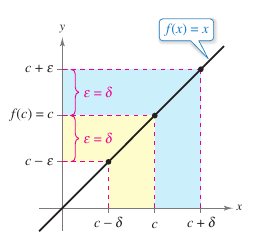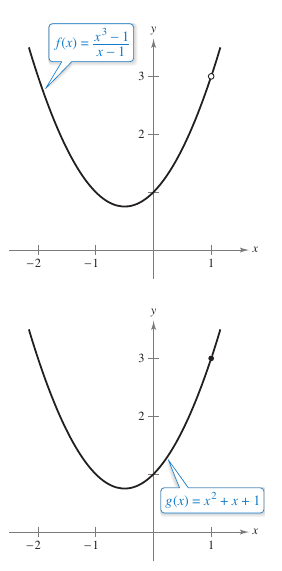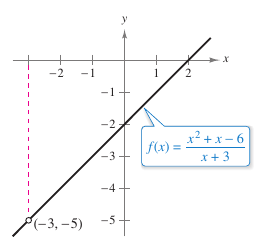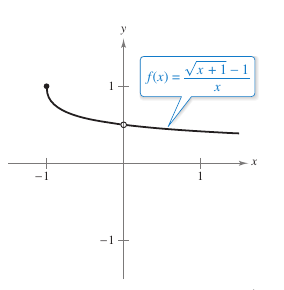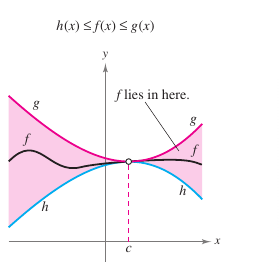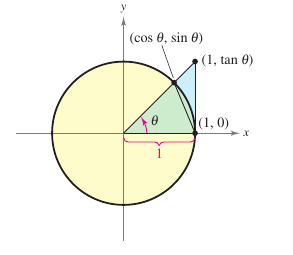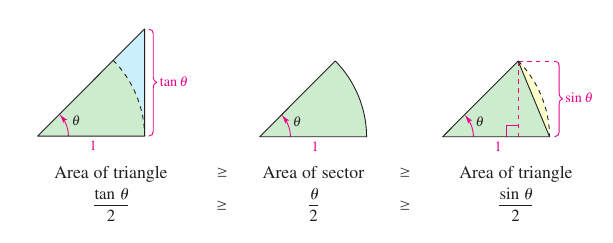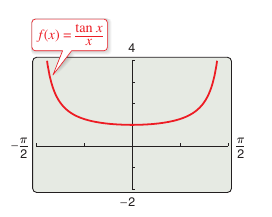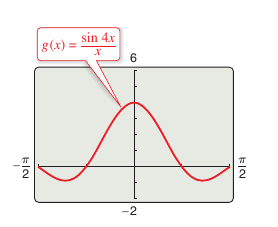Calculus I 01.03 Evaluating Limits Analytically
| Previous | Calculus I 01.02 Finding Limits Graphically and Numerically |
| Next | Calculus I 01.04 Continuity and One-Sided Limits |
Contents
- 1 Evaluating Limits Analytically
- 1.1 Limit Properties
- 1.1.1 Theorem 1.3.1 Three Basic Limits
- 1.1.2 Theorem 1.3.2 Limit Properties
- 1.1.3 Example 1.3.1 The Polynomial Limit
- 1.1.4 Theorem 1.3.3 Polynomial and Rational Function Limits
- 1.1.5 Example 1.3.2 The Rational Function Limit
- 1.1.6 Theorem 1.3.4 Radical Functions with Limits
- 1.1.7 Theorem 1.3.5 Composite Function Limits
- 1.1.8 Example 1.3.3 Composite Function Limits
- 1.1.9 Theorem 1.3.6 Trigonometric Functions Limits
- 1.1.10 Example 1.3.4 Trigonometric Function Limits
- 1.2 A Strategy for Finding Limits
- 1.3 Dividing Out Technique
- 1.4 The Rationalizing Technique
- 1.5 The Squeeze Theorem
- 1.1 Limit Properties
- 2 Internal Links
Evaluating Limits Analytically
- Evaluate a limit using limit properties.
- Develop and use a strategy for finding limits.
- Evaluate a limit using the dividing out technique.
- Evaluate a limit using the rationalizing technique.
- Evaluate a limit using the Squeeze Theorem.
Limit Properties
|
|
Section 1.2 described that the limit for \(f(x)\) as \(x\) approaches \(c\) does not depend on the value for \(f(x)\) at \(x=c\). Direct substitution can evaluate the limit in this case. That is,
Such well-behaved functions are continuous at \(c\). Section 1.4 will describe this in more detail. Theorem 1.3.1 Three Basic Limits
Proof To prove Property 2 show that for each \(\epsilon > 0\) there exists a \(\delta > 0\) such that \(\left | x-c \right | < \epsilon\) whenever \(0<\left | x-c \right | < \delta \). The obvious first choice is \(\delta = \epsilon\). The second inequality then implies the first, as shown in Figure 1.3.1. The proofs for Properties 1 and 3 in Theorem 1.3.1 are left for the student. | ||||||||
Theorem 1.3.2 Limit Properties
| Let \(b\) and \(c\) be real numbers, and let \(n\) be a positive integer, and let \(f\) and \(g\) be functions with the limits
| |
| 1. Scalar multiple: | \( \lim_{x \to c} [bf(x)]=bL \) |
| 2. Sum or difference: | \( \lim_{x \to c} [f(x) \pm g(x)]= L \pm K \) |
| 3. Product: | \( \lim_{x \to c} [f(x)g(x)] = LK\) |
| 4. Quotient: |
$$ \lim_{x \to c} \frac{f(x)}{g(x)}= \frac{L}{K}, K \neq 0$$ |
| 5. Power: | \( \lim_{x \to c} [f(x)]^n = L^n\) |
Example 1.3.1 The Polynomial Limit
Find the limit: \(\lim_{x \to 2} (4x^2+3)\).
Solution
| $$\lim_{x \to 2} (4x^2+3)$$ | $$=\lim_{x \to 2} 4x^2 + \lim_{x \to 2}3$$ | Property 2, Theorem 1.3.2 | |
| $$= 4 \left ( \lim_{x \to 2} x^2 \right ) + \lim_{x \to 2}3$$ | Property 1, Theorem 1.3.2 | ||
| \(= 4(2^2) + 3\) | Properties 1 and 3, Theorem 1.3.1 | ||
| \(=19\) | Simplify. |
Note in Example 1.3.2 that as the limit (as \(x\) approaches 2) for the polynomial function \(p(x)=4x^2+3\) is simply the value for \(p\) at \(x=2\).
- $$\lim_{x \to 2} p(x) = p({\color{Red}2 } )=4({\color{Red}2 }^2)+3=19$$
This direct substitution property is valid for all polynomial and rational functions with nonzero denominators.
Theorem 1.3.3 Polynomial and Rational Function Limits
If \(p\) is a polynomial function ath \(c\) is a real number, then
|
| If \(r\) is a rational function given by \(r(x)=p(x)/q(x)\) and \(c\) is a real number such that \(q(c)\neq 0\), then
|
Example 1.3.2 The Rational Function Limit
Find the limit:
- $$\lim_{x \to 1} \frac{x^2+x+2}{x+1}.$$
Solution Because the denominator is no 0 when \(x=1\),Theorem 1.3.3 can be applied to obtain
- $$\lim_{x \to 1} \frac{x^2+x+2}{x+1}=\frac{1^2+1+2}{1+1}=\frac{4}{2}=2.$$
Algebraic functions come in three basic types, polynomial, rational, and radical. Theorem 1.3.4 describes limits with radical functions.
Theorem 1.3.4 Radical Functions with Limits
| Let \(n\) be a positive integer. The limit below is valid for all \(c\) when \(n\) is odd, and is valid for all \(c>0\) when \(n\) is even.
|
Theorem 1.3.5 Composite Function Limits
If \(f\) and \(g\) are functions such that
and
then
|
Example 1.3.3 Composite Function Limits
Find the limit.
a. \(\lim_{x \to 0} \sqrt{x^5+4}\) b. \(\lim_{x \to 0} \sqrt[3]{2x^2-10}\)
Solution
a. Because
- $$\lim_{x \to 0} (x^2+4)=0^2+4=4 \text{ and }\lim_{x \to 4}\sqrt{x} = \sqrt{4}=2$$
the conclusion is
- $$\lim_{x \to 0} \sqrt{x^5+4} = \sqrt{4}=2.$$
b. Because
- $$\lim_{x \to 3} (2x^2-10)=2(3^2)-10=8 \text{ and }\lim_{x \to 8}\sqrt[3]{x} = \sqrt[3]{8}=2$$
the conclusion is
- $$\lim_{x \to 3} \sqrt[3]{2x^2-10} = \sqrt[3]{8}=2.$$
Many limits for algebraic functions can be evaluated through direct substitution. The six basic trigonometric functions also exhibit this quality, as shown in the Theorem 1.3.6.
Theorem 1.3.6 Trigonometric Functions Limits
| Let \(c\) be a real number in the domain for the given trigonometric functions. | ||
| 1. \( \lim_{x \to c} \sin x = \sin c \) | 2. \( \lim_{x \to c} \cos x = \cos c \) | 3. \( \lim_{x \to c} \tan x = \tan c \) |
| 4. \( \lim_{x \to c} \cot x = \cot c \) | 5. \( \lim_{x \to c} \sec x = \sec c \) | 6. \( \lim_{x \to c} \csc x = \csc c \) |
Example 1.3.4 Trigonometric Function Limits
- $$\text{a. }\lim_{x \to 0} \tan x = \tan(0)=0$$
- $$\text{b. }\lim_{x \to \pi} (x \cos x) = \left ( \lim_{x \to \pi} x \right ) \left ( \lim_{x \to \pi} \cos x \right )=\pi \cos (\pi) = - \pi$$
- $$\text{c. }\lim_{x \to 0} \sin^2 x = \lim_{x \to 0} (\sin x)^2 = 0^2 = 0$$
A Strategy for Finding Limits
|
|
Direct substitution and Theorem 1.3.7 together can be used to develop a strategy for finding limits. Theorem 1.3.7 Functions That Agree at All But One Point
Example 1.3.5 Finding the Limit for a FunctionFind the limit.
Solution Let \(f(x)=(x^3-1)/(x-1)\). By factoring and dividing out like factors produces
For all \(x\)-values other than \(x=1\), the functions \(f\) and \(g\) agree, as shown in Figure 1.3.2. Because \(\lim{x \to 1} g(x)\) exists Theorem 1.3.7 can be applied to conclude that \(f\) and \(g\) have the same limit at \(x=1\).
|
| A Strategy for Finding Limits |
| 1.Learn to recognized which limits can be evaluated by direct substitution. (These limits are listed in Theorems 1.3.1 to 1.3.6.) |
| 2. When the limit for \(f(x)\) as \(x\) approaches \(c\) cannot be evaluated by direct substitution, try to find a function \(g\) that agrees with \(f\) for all \(x\)
|
| 3. Use a graph or table to reinforce your conclusion. |
| 4.This strategy only work when a limit exists. |
Dividing Out Technique
The Rationalizing Technique
|
|
This technique involves rationalizing the numerator in a fractional expression. Recall that rationalizing the numerator mean multiplying the numerator and denominator by the conjugate of the numerator. For example, to rationalize the numerator for
multiply the numerator and denominator by the conjugate of \(\sqrt{x}+4\), which is
Example 1.3.7 Rationalizing TechniqueFind the limit:
Solution Direct substitution produces the indeterminate form \(0/0\).
Using Theorem 1.3.7 evaluates the limit.
A table or graph add additional evidence that the limit is \(\frac{1}{2}\). See Figure 1.3.4 and the table below.
|
The Squeeze Theorem
|
|
The limit for a function is squeezed between two other functions. Each has the same limit at a given \(x\)-value, as shown in Figure 1.3.5. Theorem 1.3.8 The Squeeze Theorem
Theorem 1.3.9 Two Special Trigonometric Limits
Proof The proof for the second limit is left as an exercise. To avoid confusion with how \(x\) is used the proof for the first limit is presented using the variable \(\theta\), where \(\theta\) is an acute positive angle measured in radians. Figure 1.3.8 shows a circular sector that is squeezed between two triangles.
and taking reciprocals and reversing the inequalities yields
Because \(\cos \theta =1\) and \((\sin \theta)/\theta=[\sin)-\theta)]/(-\theta)\), this inequality is valid for all nonzero \(\theta\) on the open interval \((-\pi/2,\pi/2)\). Finally, because \(\lim_{\theta \to 0} \cos \theta=1\) and \(\lim_{\theta \to 0} 1=1\), applying the Squeeze Theorem produces \(\lim_{\theta \to 0}(\sin 0)/ \theta=1\). |
Example 1.3.8 A Limit Involving a Trigonometric Function
|
|
Find the limit:
Solution Direct substitution yields the indeterminate form 0/0. To solve this problem write \(\tan x\) as \((\sin x)/(\cos x)\) and obtain
Because
and
obtains
As shown in Figure 1.3.7. |
Example 1.3.9 A Limit Involving a Trigonometric Function
|
|
Find the limit:
Solution Direct substitution yields the indeterminate form 0/0. To solve this problem rewrite the limit as
Let \(y=4x\) and observe that \(x\) approaches 0 if and only if \(y\) approaches 0 the expression can be written as
As shown in Figure 1.3.8. |
Internal Links
Parent Article: Calculus I 01 Limits and Their Properties
